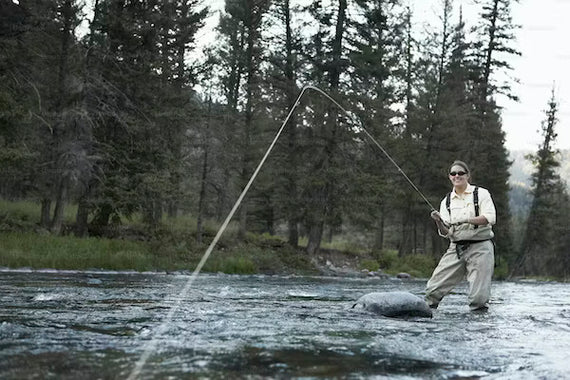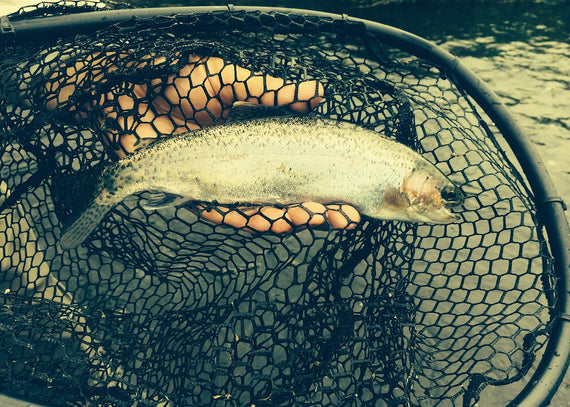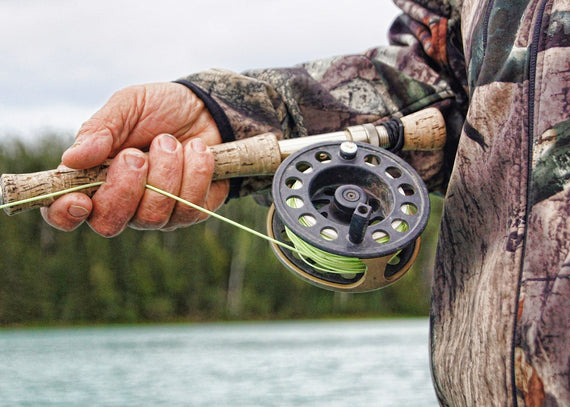With thousands of miles of rivers and streams and countless lakes scattered throughout the Bluegrass State, it’s no surprise that Kentucky is a haven for any fly fisherman or woman. The state is filled with excellent places to chase trout and other species, both near big cities and in more remote areas. With so many options out there, it can be difficult to decide where to start, so we put together this list of six of the best places to fish in Kentucky (and a few tips to help you make the most of your getaway!).
1.The Cumberland River
Ah, the crown jewel for Kentucky anglers. Similar to other Southern tailwaters, the Cumberland flows below Wolf Creek Dam and Lake Cumberland (the largest reservoir in the East) to form a tailwater so cold that trout thrive for miles.

This is a great place to throw streamers at the bank and around log jams, or to use nymphs fished deep under indicator rigs. Dry fly action can be epic, but the insect hatches are sporadic and dictated by Wolf Creek Dam’s generation, so don’t plan on that being your go-to tactic. As with any large tailwater, it’s essential to cover a lot of river at an efficient pace.
While wade fishing can be found at various boat ramps and public access areas during low generation, this river is largely too deep and swift and you’ll need a drift boat, canoe, or inflatable pontoon boat. A popular put-in is at Winfrey’s Ferry.
Adjacent to the tailwaters of Wolf Creek Dam is the newly-constructed Hatchery Creek. Over one mile long, this man-made stream features 47 feet of vertical drop on its way to the Cumberland River.
2. Otter Creek
Located just less than an hour south of Louisville, Otter Creek Outdoor Recreation Area is a wild retreat year round. For boatless anglers, Otter Creek is arguably the best and largest area in the state to wade for trout.
During the summer, Otter Creek is filled with warm water species like smallmouth, Kentucky spotted bass, and various sunfish species, which can all be taken on popping bugs cast around logs and at the end of riffles.
The state and the local fly fishing club stocks Otter Creek with trout three times in the spring and again in October. The area maintains strict catch and release regulation from October through March, so there’s no need to worry about bait fisherman keeping all the stockies for dinner.
Aside from fishing, Otter Creek has developed camping, as well as mountain biking and hiking trails, so this is a great place for a family trip (or if you want to do more than just fish while you’re here!).
3. Floyds Fork

Also south of Louisville, Floyds Fork offers a similar fishery to Otter Creek in that trout are catch and release only during the winter, and warm water species dominate during the warmer months.
Unlike Otter Creek, Floyds Fork is an excellent kayaking or canoeing destination. Because much of the riverbank is protected, Floyds Fork is considered one of the best blueway trails in the Kentucky. A great way to explore Floyds Fork is to hop aboard a paddleboard or a canoe with a small anchor, and float and fish from the numerous access points in Beckley Creek to downriver take-outs.
During the shoulder seasons where trout, bass, and sunfish may be cohabitating, throw small streamers like a black or olive wooly bugger around structure to yield a smorgasbord of species. If you’re fishing during the winter, try worm imitations like a San Juan or a squirmy wormy.
4. Elkhorn Creek
An hour east of Louisville and just north of Lexington, Elkhorn Creek offers what locals say is the best smallmouth fishing in the state.
The Elkhorn is not very deep, so you can usually wade in the creek for most of the year. The river is high enough to float a canoe, but mostly calm and shallow enough for wading anglers looking to cover a lot of ground when the gauge at Peaks Mill is between 2.5 feet to 3.5 feet.

Thanks to its location close to some of the state’s bigger cities, the Elkhorn is frequented by families and other pleasure paddlers. Lucky for the fisherman that also spend time at the creek, the Derby City Fly Fishing Club found that canoes dislodge bait holding on to rocks, sending them straight into schools of eager smallmouth bass. To imitate this, simply tie on a worm pattern, nymph, or crayfish imitation, and dead drift it to the end of riffles. This phenomenon has been deemed "the canoe hatch" and is worth trying out if you visit on a crowded weekend.
These fish don’t see a lot of fishing pressure, so throwing large streamers or obnoxious poppers will draw trophy-sized smallies to the surface. Fish around the riffles where they meet a still pool in addition to different structures like logs and bridge pilings.
5. Dix River Below Harrington Lake
The Dix River in central Kentucky is a lesser-known tailwater, but has some of the most stunning views of all the rivers listed here. The Dix is very difficult to get to and can only be accessed by small boat, but below the steep limestone cliffs, trout can be caught year round.
Start at the first boat ramp at the High Bridge on the Kentucky River, where you will then have to travel upriver and enter into the mouth of the Dix on the right. Traveling up the Dix, you will eventually pull your boat through shallow rapids, and paddle until you reach the dam. Once at the dam, you can drift back to your car and fish.
Yes, it sounds like a lot, but your effort will be rewarded with low-pressure fish that eagerly take nymphs, streamers, and a dry fly during the occasional hatch.
The truly tricky part about the Dix is dealing with the water gauges. Any significant amount of rain will raise the water level of the Kentucky River and Harrington Reservoir, forcing officials to run the generators and make the river unfishable. Look for the water level to be between 9 feet and 11 feet from the USCG gauge before venturing out.
6. Kentucky Lake

Fly fishers are naturally drawn to creeks and rivers, but it can be a lot of fun to venture out onto a still lake for large fish that require a new approach. If this what you’re after, Kentucky Lake may be the best stillwater fishing in the state.
Bordered on one side by the Land Between the Lakes Recreation Area, Kentucky Lake offers excellent fishing for all species of bass, stripers, and aggressive panfish. Plus, you’ll be immersed in a wild lake with few areas of development.
As you might guess, wading is not really an option unless you plan on bank fishing, which is perfectly fine for any fly angler willing to explore the lakeshore. Canoes and kayaks are fine, but a paddleboard is a great way to sneak up on wary fish and quietly present your fly.
Unlike the other destinations mentioned above, Kentucky Lake receives significant fishing pressure, so the larger fish will be harder to fool. This is no problem for the fly angler—simply scale down your flies to small streamers, large nymphs like a dragonfly imitation, and subtle surface flies like a sneaky pete or other sliders. Cast around fallen logs, rocks, or even the tops of old farm silos and take in the peaceful scenery.
This is an all-year fishery, but you may want to avoid weekends during the recreational boating season when the lake gets very busy.
Written by Charlie Morgan for RootsRated in partnership with Kentucky Tourism and legally licensed through the Matcha publisher network. Please direct all licensing questions to legal@getmatcha.com.



 loading="lazy"
loading="lazy"
 loading="lazy"
loading="lazy"
 loading="lazy"
loading="lazy"